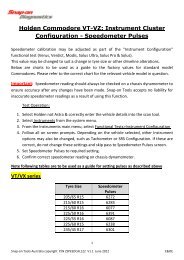Volkswagen-Audi Vehicle Communication Software Manual [888kb ...
Volkswagen-Audi Vehicle Communication Software Manual [888kb ...
Volkswagen-Audi Vehicle Communication Software Manual [888kb ...
You also want an ePaper? Increase the reach of your titles
YUMPU automatically turns print PDFs into web optimized ePapers that Google loves.
Testing<br />
Testing Engine Systems<br />
4. Road test at Wide Open Throttle (attain at least 3500 RPM).<br />
5. Decelerate.<br />
6. Perform all steps several times.<br />
Remember that all modules should be re-checked for codes after the test drive. Use automatic<br />
test mode to automatically print out all interrogated modules and codes (“00-Automatic<br />
System Test” on page 20).<br />
Important Tips for Codes<br />
• The message on the scan tool states that to clear codes, the engine must be off. Input from<br />
field technicians indicates that this is not always necessary.<br />
• Intermittent codes have the message “Error Occurs Intermittent” after the code description<br />
(VW calls these codes “sporadic”). Codes are considered intermittent if they occur for a<br />
maximum of five seconds. Intermittent codes do not turn the Check Engine Light on. They are<br />
automatically erased from memory after 40 drive cycles if they do not occur again. When a<br />
malfunction is first detected, it is stored as a static or pending malfunction. If the malfunction<br />
no longer exists after a pre-determined time or distance travelled, then it is labelled<br />
intermittent.<br />
• Most 1995 and earlier Bosch control modules may show you a false DTC “00513 - Engine<br />
Speed Sensor (G28)” if the engine is not running. This fault code should disappear once the<br />
engine is started. With a defective sensor, the engine would not start. In addition, many<br />
automatic transmission control modules may show a DTC that indicates a faulty brake light<br />
switch. This usually can be ignored and usually will not appear if you press the brakes once<br />
before checking for fault codes.<br />
• Disconnecting the battery may erase fault codes and basic settings on pre-OBD-II vehicles,<br />
which may result in driveability problems. Disconnecting the battery on OBD-II vehicles does<br />
not erase stored codes or turn the MIL off. However, intermittent codes and control unit<br />
adaptation learned values may be erased in both the engine and transmission.<br />
• Disconnecting the battery may require resetting of convenience electronics such as alarm,<br />
interior lights, radio, etc. It is recommended to use a jumper battery or battery charger to<br />
maintain power when replacing a battery.<br />
• Readiness Codes need to be reset after codes are cleared or the battery has been<br />
disconnected. Throttle body adaptation relearn is essential and may prevent the engine from<br />
starting. See “Testing Electronic Throttle Systems” on page 67 for more information.<br />
• Be aware that clearing codes may not change throttle body adaptation status to “not ready”<br />
(060 or 098), but throttle body reset is highly recommended to ensure no problems. See the<br />
<strong>Volkswagen</strong>/<strong>Audi</strong> OBD-II Readiness Code Charts for additional information.<br />
• Sometimes a fault code is displayed for a component which is not installed in the vehicle<br />
under test (i.e., a cruise control). This code cannot be cleared. Always make sure the<br />
component the code refers to is present when a code cannot be cleared.<br />
• Performing activation tests may set false codes. Always check and clear codes after<br />
performing activation tests.<br />
• <strong>Vehicle</strong>s with Drive-by-Wire (no throttle cable) cannot be power-braked. The Brake On signal<br />
notifies the control module to command the throttle closed and may also set false codes.<br />
• <strong>Vehicle</strong>s with full Drive-by-Wire (no throttle cable), usually have a EPC (Electronic Power<br />
Control) indicator light. The EPC light should come on if there is any problem in the<br />
Drive-by-Wire system. Faults detected by the EPC set duplicate fault codes in the ECM.<br />
• Electronic Instrument Clusters may store only up to four fault codes. Intermittent fault codes<br />
are automatically erased if they do not reoccur in the next 50 engine starts.<br />
41



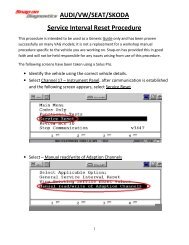

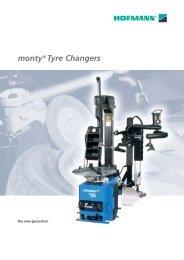
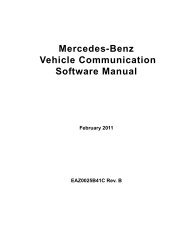

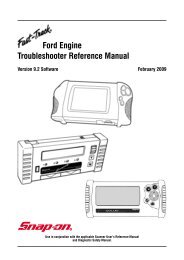

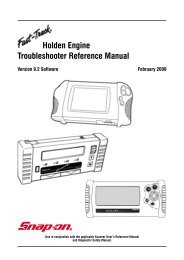
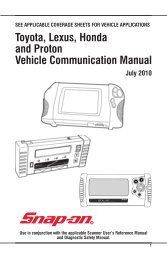
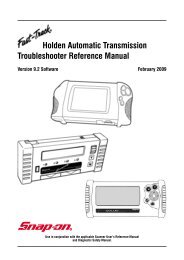
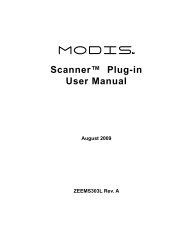
![BMW Vehicle Communication Software Manual [1198kb PDF File]](https://img.yumpu.com/41822192/1/190x247/bmw-vehicle-communication-software-manual-1198kb-pdf-file.jpg?quality=85)

